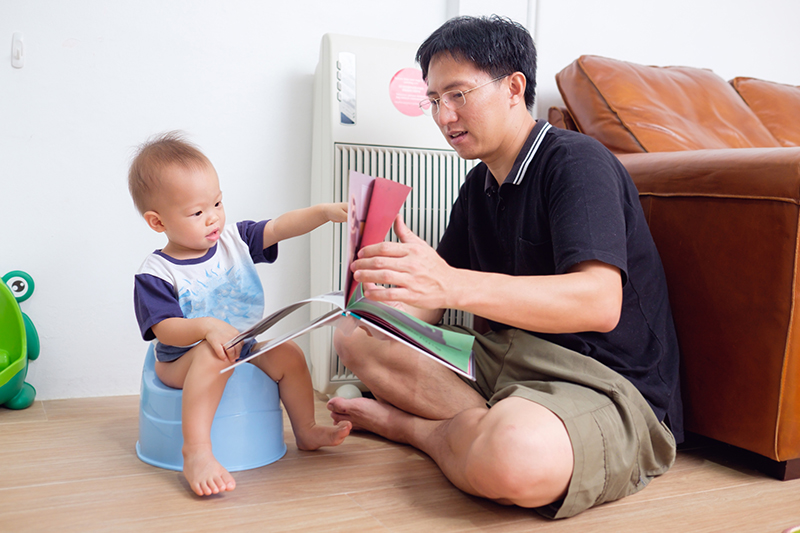Families For Life | Goodbye Diapers

Potty training is an important milestone in a child’s life. But when exactly is a child ready to swap diapers for a (mini) toilet seat? The answer is both reassuring and confusing: whenever the child is ready.
The key is not to attach a magic age for this milestone to occur. Instead, parents should look for signs that indicate a child is ready to be diaper free.
Signs of potty readiness
The following questions help you establish your child’s readiness for potty training. The more questions you answer with ‘yes’, the more likely your child is prepared.
- Can your child control his bowels or bladder for a short period of time? Little ones usually reach this stage between two to three years of age. Boys may sometimes take longer than girls to become potty ready.
- Can your child verbalise or indicate the need for a bowel movement (poo) or the urge to urinate (pee)? Alternatively, can your child tell you when diapers are wet or soiled?
- Can your child take simple instruction?
- Does your child show interest in using the toilet - just like mummy and daddy? Is your child curious to see what goes on when you use the flush?
- Can your child pull up and pull down underpants?
- Does your child understand the importance of washing hands after using the toilet?
Potty training tips
Timing
Pick the right time to potty train your child. Do not embark when there is a change in routine like home renovation, a major project at work, or when holidaying as a family. These moments may only have distractions that may hamper your potty training effectiveness.
Talk it out
Explain to your child what potty training is about. Show a pack of diapers and tell your child there will be diaper-free days once the last one has been used. By mentally preparing your child this way, you manage your child’s expectations.
Say it with books
There are many children’s books that use fun characters and entertaining stories to introduce potty training. Check out libraries and bookshops for those that work for you. Pick books which are gender specific and ones featuring characters your child can identify with. In the lead-up to potty training, read aloud from these books and let your child see the illustrations. You can go through the illustrations to familiarise your child with using the toilet.
Get equipped
Buy a potty chair or special adapter seat (also known as a ‘toilet trainer’) that fits on top of your regular toilet seat. Children prefer the potty chair because it feels more secure when they can put their feet on the floor when using it. There are many models of the potty chair available. Features of ergonomic design and high backrest are for maximum comfort. In the early stages of potty training, place the potty chair within sight of your child, to familiarise your child to it. More importantly, doing this means access is always ready. You can even personalise the potty chair with your child by decorating it with favourite stickers.
Trial run
Let your child sit, fully clothed, on the potty chair. Then let your child sit on it with clothes off to know what the potty chair feels like against the skin.
Use the potty
If your child has bowel movement at a regular time every day (like after a meal, for example), watch for signs of this need to go. Encourage your child to express the need to use the potty, or else watch for the signal from behaviour. For some children, they would go to a favourite corner of the room to poo in the diaper. For some children, they signal by scrunching up their face. When you think the time is right, lead your child to sit on the potty chair and explain what should be done.
Eat and drink right
To ensure minimal strain by your child when defecating, provide the optimal amount of fibre in the diet be in the form of fresh fruits and vegetables. Make sure your child also drinks water regularly, so the body will also purge impurities through urination. Bring your child to the potty every hour or so and to encourage release. After a few successful tries, your child should be ready to go independently.
Stay positive
When your child uses the potty independently, praise the effort. If nothing happens after five minutes of sitting on the potty, try again later. Do not lose patience over this. Also, do not pressure your child to use the potty if your child resists. Your child is perhaps not quite ready to answer the call on the potty again, in which case you can try reintroducing the experience in a couple of days or even weeks later.
The right clothes
To ensure the potty training experience goes smoothly, dress your child in clothes that are easy to put on and take off. Buttons and zips are not the easiest for tiny hands to manage, so for boys, try shorts or trousers with an elasticised waist.
Be flexible
Potty training is a natural process and must not be forced or rushed. Some children take to it in a couple of days, others take a month or more.
If your child finds it easier to control bowel movement than the bladder (or vice versa), let your child learn one process at a time.
In some instances, some children can go without diapers in the day, but need diapers when they go to sleep at night. Strategies for a diaper-free night include relieving before bedtime. Also, parents may have to wake the child once in the middle of the night to use the toilet.
With repeated practice nevertheless, your child should be able to lose those diapers — for good!